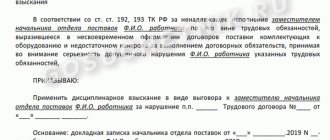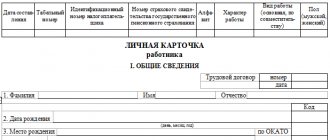On the application itself, in the upper right corner of the first sheet, the word “Appendix” is printed (if there are several applications, they are numbered) and it is indicated which order or point of the order the application relates to, for example: Dictionary of personnel records management. An order is a legal act issued by the head of a management body acting on the basis of unity of command to ensure basic and operational activities. Appendix to the order - materials of a reference, documentary or other nature, additional to the main text of the order. If the appendix to the order is an approved document (regulations, rules, instructions, etc.), an o is made in the corresponding paragraph of the administrative part, and the document approval stamp is placed on the appendix in the upper right corner.
Types of orders
In total, there are 3 types of acts, divided into groups depending on the subject and purpose of their preparation:
- Solving organizational issues . For example, an order may concern the liquidation/reorganization of a company, the creation of collegial bodies, the formation of a schedule, and the management of the company at all levels.
- Issues related to production activities . For example, an order may concern the procedure for financing a company and providing materials. The document is needed to create a scientific and technical policy and summarize the results of the company’s work.
- Questions regarding personnel . The order may concern the hiring of employees, training of employees, or transfer to another position. Based on the document, specialists are encouraged and workers are dismissed. It is needed to implement social guarantees: payments to pregnant women, financial assistance.
Almost all important decisions in the company are made on the basis of orders.
48) Requirements for the preparation and execution of orders for core activities.
Order
- a legal act issued by the head of an organization (its structural unit), acting on the basis of sole decision-making, in order to resolve the main and operational tasks in the organization’s activities.
There are three types of orders:
order on administrative and economic issues;
order on the main activity;
personnel order.
An order is the most common type of administrative document used in management practice. It is published on issues of creation, liquidation, reorganization of institutions or their structural divisions, approval of regulations, instructions, rules and similar documents requiring approval, organization of an enterprise, as well as on personnel issues of hiring, moving, dismissing workers, etc. By means of an order, the manager sets the main tasks for employees and indicates ways to resolve fundamental issues.
Let's consider orders on the main activities of the organization.
There are three stages in preparing an administrative document:
studying the essence of the issue and preparing a draft document;
discussion and adoption of the document at meetings of the collegial body (in the case of resolutions, decisions);
approval of the document and its signing.
Orders for the main activity are drawn up on the letterhead of the enterprise and contain a set of the following details: name of the enterprise, type of document, date, index, place of preparation or publication, title to the text, text, signature, approval marks, visas, mark on the execution of the document.
Completing the main part of the order
The preparation of an order is based on a detailed and comprehensive study of the issue, since the instructions contained in the orders must be specific and real, they must be provided with sufficient logistical and financial resources to eliminate the need in the future to adjust or cancel decisions made due to their incompleteness or imperfection .
Heading for the order
should be formulated clearly and as briefly as possible, expressing the main content of the document.
·Text of the order
consists of two parts: ascertaining and administrative, separated from each other.
The stating part
is an introduction to the essence of the issue and justifies the issuance of the order. It can list facts, events, and evaluate them. If the order is prepared on the basis of documents of other organizations or previously published documents, then their details are indicated in the ascertaining part of the order: name of the document, name of the author organization, date and registration number of the document, title to the text in quotation marks. The last sentence of the ascertaining part is not given a period. The administrative part of the order begins with the word “I ORDER”, which is printed in capital letters on a separate line from the left margin of the document. It is followed by a colon.
Then the text of the administrative part of the order follows from a new line paragraph. The language used here must be specific, clear, unambiguous and linguistically correct. They should not contradict previously published regulatory and administrative documents issued in this organization and in the legal field of Russia in general.
If the administrative part of the order involves actions or instructions of different nature that will be executed by several executors, then it should be divided into paragraphs
, which are numbered with Arabic numerals.
If the text of the order contains subparagraphs, then it is also better to number them in Arabic numerals (their number will consist of the serial number of the paragraph, a dot and the serial number of the subparagraph within the paragraph, etc.). The number of nesting levels can be different (somewhere 1 level, somewhere – 2, somewhere – 3, etc.); Numbering, of course, will help determine what belongs where, but you should not overuse it. Each paragraph indicates the performer, the prescribed action and the deadline for execution
. It is recommended to indicate the performer in the dative case, in which case not only his last name is given, but also his position (possibly with the name of the structural unit) - see point 1 in Example 6. If the prescribed action will be performed by several performers at the same time, then in this case the performers may be are indicated in general. The prescribed action is expressed by a verb in an indefinite form - “develop”, “approve”, “prepare”, “put into operation”, etc.
The deadline must be set for each task separately. It is not allowed to formulate tasks without establishing an appropriate deadline.
Preparation of attachments to the order
If there is a large volume of text, only the main issues are stated in the order itself, and the rest of the text is included in appendices to the order. Graphs, diagrams, tables, lists, organizational and legal documents - regulations, instructions, rules, regulations approved by order, etc. can be drawn up in the form of attachments.
In the text of the order, in the relevant paragraphs of the administrative part, it is necessary to provide links to the annexes:
…(application) – if there is only one application;
. (Annex 1) . (Appendix 2) – if there are several applications.
On a document that is an appendix, the word “Appendix” is printed in the upper right corner of the first sheet, indicating which order or clause of the order it relates to.
If the appendix to the order is an approved document (regulations, rules, instructions, etc.), a note is made in the corresponding paragraph of the administrative part: . (application)
, and the document approval stamp is placed on the application in the upper right corner.
The application label can be formatted in a centered manner or with lines aligned to the left.
Endorsement and signature
Before being submitted for signature, the order is endorsed by all interested officials, a lawyer and deputy heads of the organization. If the employee who endorses the order has objections or additions, they are stated in a separate certificate, which is attached to the draft document, and the visa is supplemented with the phrase “There are comments” or “Comments are attached.” Editorial comments may be added directly to the submitted draft document.
If significant comments and additions were made during approval, the order is revised by the executor and re-approved. If, during approval, editorial clarifications are made that do not change the essence of the document, re-approval is not required.
After the order is finalized, before it is submitted to the manager for signature, the order must be endorsed by all interested parties. Visas are affixed to the reverse side of the last sheet of the order or on a separate approval sheet, which is attached to the order, constituting its integral part. The visa includes: the employee's position, his signature, initials, surname and date.
Under the visas, a mark about the performer is placed, consisting of the name of the performer (project creator) and his office telephone number. On the reverse side of the order, at the bottom of the sheet, a mark may be placed on the distribution of the order indicating the structural units or their heads. Information about the distribution of an order can be placed on a separate sheet - a mailing list (index, sheet).
If orders are signed by the head of the organization. The signature in the order is drawn up in the same way as in any other document drawn up on letterhead.
Only one copy of the order is signed (with the exception of joint orders). The manager's signature on the order is not certified by a seal.
The first copy of the order after registration is filed with orders on the main activities of the organization. Orders must be registered on the day they are signed, otherwise executors may have problems executing the order, especially if the execution period is short.
After signing and registration, copies are made of the order and sent to all performers. Email can be used to send orders. If copies of the order are issued for submission to other organizations, they are certified using the “Copy Certification Mark” requisite.
https://youtu.be/Qc9xfobPvVs
Contents of orders concerning employees
Orders are a tool for regulating relations between employees and the employer. They are formed in the presence of these circumstances:
- Getting an employee a job or terminating an employment agreement.
- Going on vacation.
- Going on a business trip.
Orders concerning employees are filled out according to the approved form. Their content is divided into 2 parts: introductory and administrative.
Introductory part
The introductory part sets out the goals and objectives of the new regulations. That is, an explanation is provided for the decisions made. If this is an order adopted in pursuance of government regulations, the introductory part indicates the number of this order, date and title.
Administrative part
The beginning of this part is the phrase “I command.” After this, you need to record your orders. You can create a numbered list for ease of presentation. The deadline for the execution of orders is either set for each item separately, or placed in a separate item. A separate paragraph also contains a list of employees responsible for implementing the provisions of the order.
The difference between an order and an instruction
Order and instruction are papers that are very similar. They are often confused with each other. An order is an act with a long-term effect. The validity of the document does not terminate upon the occurrence of the specified circumstance. An example of an order is a document on hiring a specialist. This document is published by the director/manager of the company, deputy director.
An order is an operational act that is relevant until the occurrence of a certain circumstance. An example of such a document is an order on the formation of a commission. It will be in effect until this commission resolves the required issue. A relatively wide range of employees can sign orders.
An order is the basis for the emergence or change of legal relations. The order is issued to solve problems relating to existing legal relations. The order may be amended if required. If adjustments need to be made to the order, it is usually reissued.
Both documents can only regulate the activities of the company to which they relate. However, acts often affect legal relations with the company’s counterparties.
Details about GOST for document preparation
Font
The Regulations indicate a list of free fonts that are recommended to be used when composing a document, in particular:
The preferred font size is set to 12 to 14.
It is also allowed to use fonts similar in style to the base ones.
Information and data presented in tabular form may have a smaller font size than the main text.
Bold font should be used to highlight:
Spacing and indentation
To make the text on paper look orderly and beautiful, you must adhere to the following rules:
- Set the overall paragraph indent to 1.25;
- Compliance with fields:
- 20 mm – top and bottom;
- 10 mm – right;
- 20 mm – left;
- If a document on paper must be stored in an archive for 10 years or more, then the left margin is increased to 30 mm. This procedure is due to the need for subsequent firmware, re-flashing due to the loss of the paper’s original qualities;
- The interval is set according to the following parameters:
- Letter spacing is normal;
- Single space between words;
- The document is scaled down using 2 spacing;
- Line spacing – from 1 to 1.5;
- Details given on several lines – 1 interval;
- If a document contains a group of details, an additional space must be maintained between each of them to separate the information.
Alignment
When drawing up a document in accordance with GOST, it is necessary to use width alignment. To avoid distortion of intervals and the appearance of large spaces, you should enable the wrap function when aligning.
In cases where text or details need to be included in the left corner, the rule of maximum line length is a multiple of 7.5 cm. That is, the text of each line can occupy no more than 1/3 of an A4 sheet.
Information presented in the center of the document should occupy no more than 12 cm (half an A4 sheet).
Requisites
Document details according to GOST contain the following information about the sender:
- Company logo or trademark – top center or left;
- The unofficial name of the enterprise, if it is more common in the customs of business transactions with counterparties;
- The title of the document is at the top in the middle of the sheet;
- Mandatory (basic) company details are contained at the top of the document:
- Company name;
- Registration address;
- TIN;
- OGRN;
- Email, fax;
- Other contact details;
- The document is always dated not on the day it was drawn up, but on the day it was signed by an authorized employee. The place for the indicated mark is the top margin of the sheet. It is customary to use the date format: day-month-year.
Location of details on the title page of the document:
Rules for addressing the addressee
When drawing up a document, the following rules apply to the recipient of the appeal (addressee):
- On paper, the addressee’s details should be located either under the sender’s details or in the upper corner of the sheet;
- When indicating the addressee, different cases may be used, in particular:
- Addresses to individuals and individual entrepreneurs are written in the dative case (to whom).
- The addressee-company is addressed in the nominative case (who).
Ministry of Health of the Russian Federation;
- A document intended for a subsidiary of a company, branch or division must be drawn up using the nominative case to the name of the company and the dative case to the division and position of the authorized specialist.
LLC Agrocomplex Nikolaevsky
Head of the packaging department
- According to the new GOST, changes have also been introduced regarding the initials of the addressee. If previously the recipient's initials were placed before the surname, now they are after the surname.
Previous edition: I.N. Nikolaeva;
Current edition: Nikolaeva I.N.
It is allowed to use “Ms,” “Mr” (Mrs. and Mr., respectively) in address.
How to compose a document for several recipients
According to office work standards, no more than 4 addressees can be indicated in one document. If the appeal is aimed at a larger circle of people, then one of the following alternatives is used:
- The list of addressees is compiled on separate paper and a copy of the application document is attached;
- The addressees are anonymized (without indicating last names) and are united only by a single position. For example:
To the managers of the North Baikal division of Roshstroy LLC.
The rules for document execution for several addressees presented in GOST are in practice only applicable to requests on paper, since electronic forms:
- They may not contain the addressee’s details at all;
- Without prejudice to the information content, the number of addressees may be indicated in excess of that established by the regulations - more than 4;
- Electronic correspondence and types of documents do not allow you to provide information about addressees in a separate list.
If the document contains a trade secret
Some documents may contain information related to trade secrets. That is why one of the amendments to the new GOST affects this information (in the earlier edition, trade secrets were not mentioned at all).
Answer
Please note that the date of the document is a mandatory requisite for any document, including local regulations ( see appendix to the answer below
).
In addition, the publication of a local regulatory act without specifying a date may lead to disputes regarding its application over time ( Article 12 of the Labor Code of the Russian Federation
), which may entail risks for the employer. For example, if an employee claims that a given local regulation was drawn up later than it actually was, it will be difficult for the employer to prove that he is right.
You will learn more about termination of local regulations if you go to the material.
Thus, we recommend that the local regulatory act be drawn up in a new edition, indicating the date of its preparation. The annex to the local regulatory act should be approved indicating the name of the relevant document and the date of its approval. For example: “ Appendix to the certification regulations dated March 29, 2016
».
Details in the materials of the Personnel System:
Revision dated January 1, 2015
Mandatory document details
We recommend reading about the Order on the introduction of local regulations at this link.










